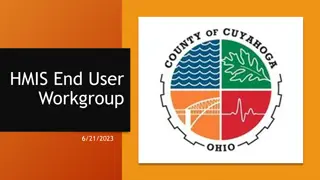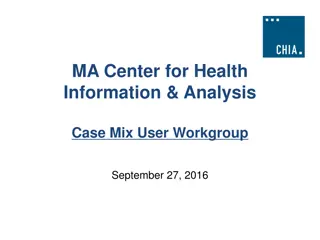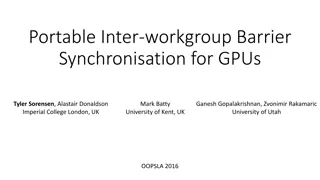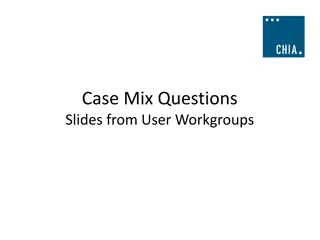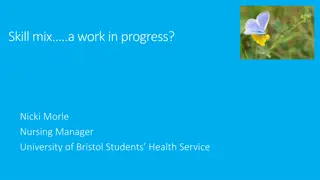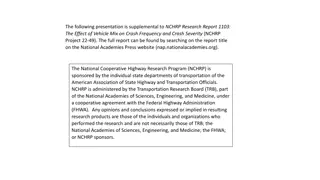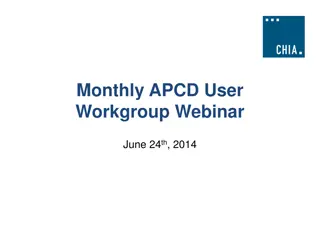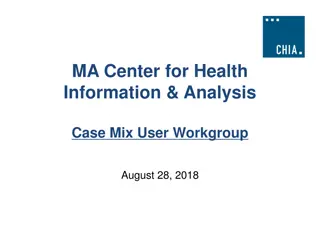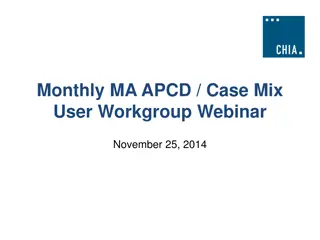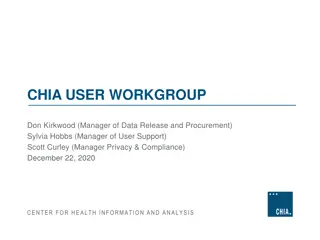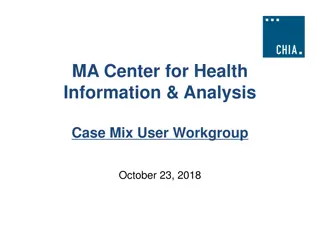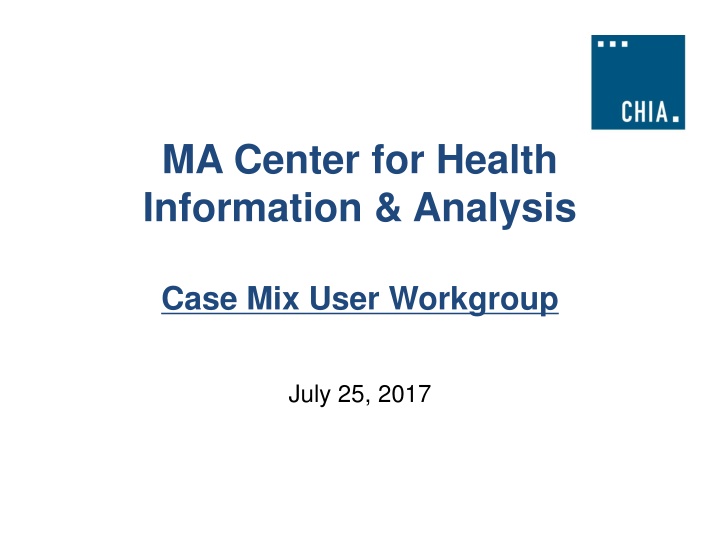
Case Mix Data Release Process and Application Guidelines
Discover the latest information from MA Center for Health Information & Analysis on case mix data release process, application reminders, and user support guidelines. Stay updated on release timeframes, revisions, and changes for 2017.
Download Presentation

Please find below an Image/Link to download the presentation.
The content on the website is provided AS IS for your information and personal use only. It may not be sold, licensed, or shared on other websites without obtaining consent from the author. If you encounter any issues during the download, it is possible that the publisher has removed the file from their server.
You are allowed to download the files provided on this website for personal or commercial use, subject to the condition that they are used lawfully. All files are the property of their respective owners.
The content on the website is provided AS IS for your information and personal use only. It may not be sold, licensed, or shared on other websites without obtaining consent from the author.
E N D
Presentation Transcript
MA Center for Health Information & Analysis Case Mix User Workgroup July 25, 2017
Agenda Announcements Update on the status of Case Mix FY16 New CHIA report: Emergency Department Visits after Inpatient Discharge User Questions Q&A
Case Mix FY16 Release Calendar *CURRENT* RELEASE TIMEFRAMES FOR EACH FILE: Inpatient (HIDD) READY NOW Emergency Department (ED) AUGUST Outpatient Observation (OOD) SEPTEMBER
Case Mix Application Process Recap of Changes for 2017: Now charge per year of data requested Can now request future years of data Future years require no DRC review, absent major changes to the project or data being requested Can request to use data for one project for a subsequent project Comprehensive DUAs for each organization (will cover all projects instead of multiple DUAs for each specific project)
Revised Data Release Process Applicants can now request FUTURE YEARS OF DATA Initial project requires Data Privacy Committee and Data Release Committee review Additional years (up to 5 years) or release versions of data will be released upon availability and the Recipient s completion of a Certificate of Continued Need (Exhibit B of the revised DUA) No additional review required for these additional years of data Normal data fees still apply
Application Reminders Applicants should not use de-identified in their application in referring to the data received from CHIA. CHIA datasets are not de-identified as the term is defined by HIPAA. Also, make sure your IRB approval is valid for the period you intend to use the data. Please remember your application documents must be signed by the appropriate people when you submit them on IRBNet.
More Reminders If you re requesting user support, please do not send us any data Aggregate, de-identified data is fine, but sending us any other data may not be allowed. As a general rule, users should not send record or claim-line data to the User Support Team Considered a breach of our Data Use Agreement Run the risk of not being allowed to request data from CHIA in the future
New Papers and Reports Using CHIA Data CHIA Data Users asked to be alerted to when new papers and reports are available using CHIA Case Mix Data or All Payer Claims Data. The following new papers and reports are available: All Payer Claims Data Barnett ML, Song Z, Rose S, Bitton A, Chernew ME, Landon BE. Insurance Transitions and Changes in Physician and Emergency Department Utilization: An Observational Study. Journal of General Internal Medicine. 2017 May 18:1-0. https://link.springer.com/article/10.1007/s11606-017-4072-4 Figueroa JF, Frakt AB, Lyon ZM, Zhou X, Jha AK. Characteristics and spending patterns of high cost, non- elderly adults in Massachusetts. InHealthcare 2017 July 1. Elsevier. http://www.sciencedirect.com/science/article/pii/S2213076417300350 McCoy TH, Castro VM, Cagan A, Roberson AM, Perlis RH. Validation of a risk stratification tool for fall- related injury in a state-wide cohort. BMJ open. 2017 Feb 1;7(2):e012189. http://bmjopen.bmj.com/content/bmjopen/7/2/e012189.full.pdf Case Mix Data Fran a UL, McManus ML. Availability of Definitive Hospital Care for Children. JAMA pediatrics. 2017 July 10:e171096 Supplement. http://jamanetwork.com/journals/jamapediatrics/article-abstract/2634361 Center for Health Information and Analysis, Emergency Department Visits After Inpatient Discharge in Massachusetts State Fiscal Year 2015, July 2014. http://www.chiamass.gov/emergency-department- visits-after-inpatient-discharge
New Papers and Reports Using CHIA Data (continued) Case Mix Data (Multi-State Comparison using AHRQ HCUP Data) Weiss AJ (IBM Watson Health), Bailey MK (IBM Watson Health), O'Malley L (IBM Watson Health), Barrett ML (M.L. Barrett, Inc.), Elixhauser A (AHRQ), Steiner CA (Institute for Health Research, Kaiser Permanente). Patient Characteristics of Opioid-Related Inpatient Stays and Emergency Department Visits Nationally and by State, 2014. HCUP Statistical Brief #224. June 2017. Agency for Healthcare Research and Quality, Rockville, MD. www.hcup-us.ahrq.gov/reports/statbriefs/sb224-Patient-Characteristics-Opioid-Hospital-Stays-ED-Visits-by-State.pdf Massachusetts Highlights from AHRQ HCUP Report In most States in 2014, females had a higher rate of opioid-related inpatient stays than males but males had a higher rate of opioid- related ED visits than females. However, in Massachusetts males had both a higher rate of opioid-related inpatient stays and ED visits. Across all patient sex and age groups in 2014: Opioid-related inpatient stays were lowest in Iowa, Nebraska, Texas, and Wyoming and highest in Massachusetts. Note: Asterisks denote States where the difference between the higher and lower of the male and female rates was at least 10 percent. Opioid-related inpatient rates are per 100,000 population. State-level inpatient rates by sex are provided in Appendix A of report.
Question: Are there differences in the completeness of UHIN data by race, age, and facility? Answer: Yes, when looking at the UHIN field for adults or the mother s UHIN for infants, 72% of hospitals have less than 10% incomplete UHINs (see table below). The four hospitals with greater than 50% incomplete UHINs have a higher proportion of pediatric population, such as Children s Hospital (mean age 8 years old), and a higher proportion of senior population, such as New England Baptist (mean age 67 years old). FY2015 Inpatient Hospital Discharge Percent Completeness of Valid UHIN 80% 70% 60% 50% 40% 30% 20% 10% 0%
Question: Are there differences in the completeness of UHIN data by race, age, and facility? (continued) Answer: In looking at the completeness of UHIN by Race 1 in the FY2015 Inpatient Discharge, patients with Unknown Race 1 had the highest percentage of UHIN errors and American Indians/Alaskan Natives had the highest percentage of missing UHINs. FY2015 Race 1 Comparison of Percent Missing and UHIN Error 40% 35% 36.44% UHIN Error Missing UHIN 30% 25% 23.65% 20% 22.18% 15% 15.45% 10% 12.91% 5% 8.43% 7.78% 0% R1 (AI/AN) R2 (Asian) R3 (Black) R4 (NH/OPI) R5 (White) R9 (Other Race) Unknown Missing UHIN 25.18% 15.35% 7.62% 19.76% 5.14% 17.09% 20.77% Race 1 UHIN Error Invalid UHIN R1 (American Indian/Alaska Native) R2 (Asian) R3 (Black) R4 (Native Hawaiian or Other Pacific Islander R5 (White) R9 (Other Race) Unknown 7.78% 22.18% 12.91% 23.65% 8.43% 15.45% 36.44% 0.09% 0.02% 0.03% 0.00% 0.05% 0.04% 0.02%
Question: Are there differences in the completeness of UHIN data by race, age, and facility? (continued) Answer: In the Hospital Inpatient Discharge data from FY2014 to FY2015, there has been small 1.67% increase in Valid UHINs attributable to a decrease in UHIN errors and invalid UHINs but paralleled by an increase in missing UHINs. Comparison of Completeness of FY2014 and FY2015 Inpatient Discharge UHINs Valid UHIN UHIN Error Missing UHIN Invalid UHIN 90% 81.93% 81.73% 80% 70% 60% 50% 40% 30% 14.95% 20% 10.95% 7.08% 10% 3.24% 0.03% 0.02% 0% 2014 2015
Question: Why would a patient with a length of stay of 1-day be admitted instead of seen in Observation Stay? Answer: While the CHIA Case Mix data contains data collected from acute care hospitals on inpatient hospital discharges, emergency department visits, and observation stays, 105 CMR 130.000 Massachusetts Hospital Licensure Regulations which falls under the regulatory authority of the Massachusetts Department of Public Health provides specific guidance and standards for the utilization of different hospital care settings. See: http://www.mass.gov/eohhs/docs/dph/regs/105cmr130.pdf
Questions? Questions related to APCD : (apcd.data@state.ma.us) Questions related to Case Mix: (casemix.data@state.ma.us) REMINDER: Please include your IRBNet ID#, if you currently have a project using CHIA data
Where can I find old User Workgroup presentations? http://www.chiamass.gov/ma-apcd-and-case-mix-user-workgroup-information/
Call for Topics and Presenters If there is a TOPIC that you would like to see discussed at an MA APCD or Case Mix workgroup, contact Adam Tapply [adam.tapply@state.ma.us] If you are interested in PRESENTING at an MA APCD or Case Mix workgroup, contact Adam Tapply [adam.tapply@state.ma.us] You can present remotely from your own office, or in-person at CHIA.

